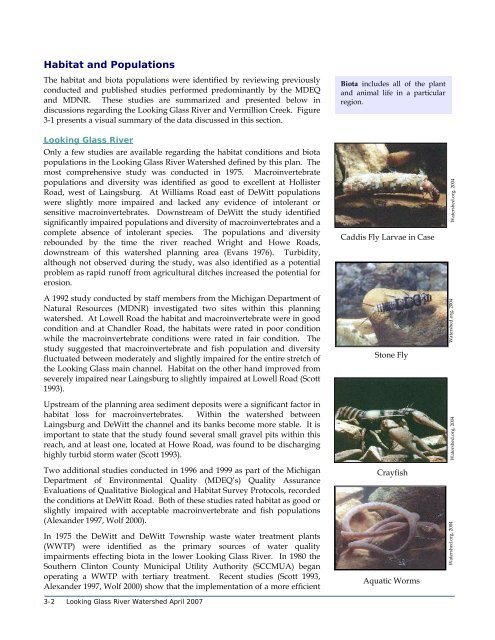Looking Glass River Watershed Management Plan - Greater ...
Looking Glass River Watershed Management Plan - Greater ...
Looking Glass River Watershed Management Plan - Greater ...
Create successful ePaper yourself
Turn your PDF publications into a flip-book with our unique Google optimized e-Paper software.
Habitat and Populations<br />
The habitat and biota populations were identified by reviewing previously<br />
conducted and published studies performed predominantly by the MDEQ<br />
and MDNR. These studies are summarized and presented below in<br />
discussions regarding the <strong>Looking</strong> <strong>Glass</strong> <strong>River</strong> and Vermillion Creek. Figure<br />
3-1 presents a visual summary of the data discussed in this section.<br />
<strong>Looking</strong> <strong>Glass</strong> <strong>River</strong><br />
Only a few studies are available regarding the habitat conditions and biota<br />
populations in the <strong>Looking</strong> <strong>Glass</strong> <strong>River</strong> <strong>Watershed</strong> defined by this plan. The<br />
most comprehensive study was conducted in 1975. Macroinvertebrate<br />
populations and diversity was identified as good to excellent at Hollister<br />
Road, west of Laingsburg. At Williams Road east of DeWitt populations<br />
were slightly more impaired and lacked any evidence of intolerant or<br />
sensitive macroinvertebrates. Downstream of DeWitt the study identified<br />
significantly impaired populations and diversity of macroinvertebrates and a<br />
complete absence of intolerant species. The populations and diversity<br />
rebounded by the time the river reached Wright and Howe Roads,<br />
downstream of this watershed planning area (Evans 1976). Turbidity,<br />
although not observed during the study, was also identified as a potential<br />
problem as rapid runoff from agricultural ditches increased the potential for<br />
erosion.<br />
Biota includes all of the plant<br />
and animal life in a particular<br />
region.<br />
Caddis Fly Larvae in Case<br />
<strong>Watershed</strong>.org, 2004<br />
A 1992 study conducted by staff members from the Michigan Department of<br />
Natural Resources (MDNR) investigated two sites within this planning<br />
watershed. At Lowell Road the habitat and macroinvertebrate were in good<br />
condition and at Chandler Road, the habitats were rated in poor condition<br />
while the macroinvertebrate conditions were rated in fair condition. The<br />
study suggested that macroinvertebrate and fish population and diversity<br />
fluctuated between moderately and slightly impaired for the entire stretch of<br />
the <strong>Looking</strong> <strong>Glass</strong> main channel. Habitat on the other hand improved from<br />
severely impaired near Laingsburg to slightly impaired at Lowell Road (Scott<br />
1993).<br />
Stone Fly<br />
<strong>Watershed</strong>.org, 2004<br />
Upstream of the planning area sediment deposits were a significant factor in<br />
habitat loss for macroinvertebrates. Within the watershed between<br />
Laingsburg and DeWitt the channel and its banks become more stable. It is<br />
important to state that the study found several small gravel pits within this<br />
reach, and at least one, located at Howe Road, was found to be discharging<br />
highly turbid storm water (Scott 1993).<br />
Two additional studies conducted in 1996 and 1999 as part of the Michigan<br />
Department of Environmental Quality (MDEQ’s) Quality Assurance<br />
Evaluations of Qualitative Biological and Habitat Survey Protocols, recorded<br />
the conditions at DeWitt Road. Both of these studies rated habitat as good or<br />
slightly impaired with acceptable macroinvertebrate and fish populations<br />
(Alexander 1997, Wolf 2000).<br />
In 1975 the DeWitt and DeWitt Township waste water treatment plants<br />
(WWTP) were identified as the primary sources of water quality<br />
impairments effecting biota in the lower <strong>Looking</strong> <strong>Glass</strong> <strong>River</strong>. In 1980 the<br />
Southern Clinton County Municipal Utility Authority (SCCMUA) began<br />
operating a WWTP with tertiary treatment. Recent studies (Scott 1993,<br />
Alexander 1997, Wolf 2000) show that the implementation of a more efficient<br />
3-2 <strong>Looking</strong> <strong>Glass</strong> <strong>River</strong> <strong>Watershed</strong> April 2007<br />
Crayfish<br />
Aquatic Worms<br />
<strong>Watershed</strong>.org, 2004<br />
<strong>Watershed</strong>.org, 2004





